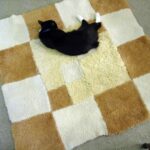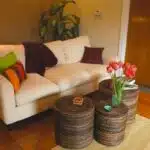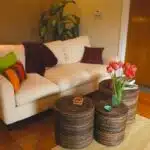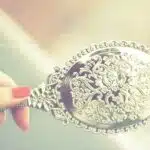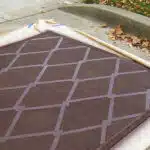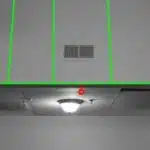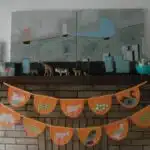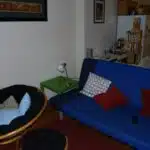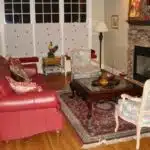As an interior design expert, one of the most frequently asked questions I receive is how to incorporate rugs into wall decor. Rugs are a versatile and unique way to add texture and interest to any space, but hanging them on walls can be tricky without the proper techniques and tools. In this article, I will guide you through the process of hanging rugs on walls, providing step-by-step instructions to ensure your finished product looks polished and professional.
Before we dive into the specifics of hanging rugs on walls, it’s important to understand why this trend has gained popularity in recent years. Rugs not only create a cozy and inviting atmosphere when placed on floors, but they also make for stunning art pieces when hung vertically on walls. Whether you have an antique rug that deserves to be displayed prominently or a modern piece that complements your decor theme, hanging a rug is an eye-catching way to add personality and depth to your home. With the right approach, anyone can master this technique and elevate their space with beautiful, statement-making wall art.
Choosing The Right Rug For Wall Hanging
When it comes to hanging rugs on your wall, selecting the right rug is crucial. It’s important to choose a rug that suits the style and aesthetic of your space. Additionally, you should consider the material of the rug. Not all rugs are suitable for wall hanging, so it’s important to select one that is durable enough to last.
One thing to consider when selecting a rug for wall hanging is its material. Wool and cotton are popular materials because they’re durable and can withstand the weight of being hung on a wall. Silk rugs, on the other hand, may be too delicate for this purpose. It’s also important to select a rug that has a sturdy backing.
Another factor to consider is color coordination. The color of your rug should complement the other decor in your room. If you have neutral walls and furniture, you may want to choose a rug with bold colors or patterns that will add interest and depth to your space. Conversely, if you have colorful furnishings or busy wallpaper, you may want to choose a more subdued rug so as not to overwhelm the room.
Once you’ve selected the perfect rug for your wall hanging project, it’s time to measure your wall space so you know exactly how much area needs covering. This will help ensure that your rug fits perfectly on your wall without any awkward gaps or overlaps.
Measuring Your Wall Space
Accurately measuring wall space is essential for successful wall-mounted rug displays. To begin, use a tape measure to identify the height and width of the wall. Then, use a pencil to mark the desired width and height of the rug area on the wall. After the wall space has been marked, you can arrange the rug to best fit the area.
Measuring Walls
Measuring Walls is an essential part of hanging rugs on the wall. To ensure Measuring accuracy, it’s important to use a tape measure and take the measurements in inches or centimeters. Take the height and width of the area where you want to hang your rug. It’s best to measure twice to avoid any mistakes.
Wall space limitations can be a challenge when hanging rugs on the wall. If you have low ceilings, consider hanging your rug horizontally, whereas if you have high ceilings, vertically can work better. Additionally, make sure that there is at least 6-12 inches of clearance on all sides of the rug for proper visual balance.
In summary, measuring walls accurately and considering wall space limitations is crucial when hanging rugs on the wall. It’s important to take proper measurements using a tape measure and account for any obstacles like windows or doors in your wall space. By taking these steps into consideration beforehand, you can ensure that your rug hangs perfectly on your wall while also adding a touch of décor to your living space!
Marking Wall Space
When it comes to hanging rugs on the wall, measuring accurately is just the first step. The next important step is marking your wall space. This ensures that you know exactly where to install your rug and that it will be level and straight. Marking your wall space also allows you to account for any obstacles like windows or doors, ensuring that your rug hangs perfectly.
To mark your wall space, use a pencil or chalk to draw lines where your rug will hang. Consider the texture of your walls when doing this, as some materials like brick or stucco may require different methods for marking. For example, if you have a textured wall, it may be best to create small circles with the pencil instead of lines for better visibility.
It’s important to remember that marking your wall space should be done after measuring accurately. By taking both of these steps into consideration, you can ensure that your rug hangs perfectly on your wall while also adding a touch of décor to your living space! Don’t forget to take into account any obstacles or texture considerations when marking and measuring for the best results.
Preparing Your Rug For Hanging
Before hanging your rug on the wall, it is important to prepare it properly. This includes cleaning the rug thoroughly and adding a decorative edging if desired. Cleaning tips vary depending on the type of material your rug is made of, but generally, you can use a vacuum cleaner or a soft-bristled brush to remove any dust or dirt that has accumulated on the surface.
In addition to cleaning your rug, you may want to add a decorative edging to enhance its appearance. A variety of options are available including fringing, binding, and serging. Fringing involves adding long tassels to the edges of the rug while binding involves stitching a narrow strip of fabric around the perimeter. Serging is similar to binding but uses an overlocking stitch instead of straight stitch.
By preparing your rug properly before hanging it on the wall, you will ensure that it looks its best and lasts longer. Once your rug is clean and edged appropriately, you can move on to selecting the right hanging hardware that will keep it securely in place without causing damage to either the rug or your wall.
Selecting The Right Hanging Hardware
Now that your rug is properly prepared for hanging, it’s time to select the right hardware. There are a variety of types of hardware available, so it’s important to choose the one that will best support your rug. For lighter rugs, simple picture hangers or adhesive strips may be sufficient. However, for heavier rugs, you’ll need to consider more heavy-duty options.
When selecting hardware for heavy rugs, it’s important to keep the weight and size of your rug in mind. One option is a French cleat system, which involves attaching a metal bracket to the back of your rug and another bracket to your wall. These brackets interlock and provide a secure way to hang heavy rugs. Another option is a J-hook system, which involves screwing hooks into the wall and using wire or cord to hang your rug from them.
Tips for heavy rugs include making sure you locate studs in your wall before hanging anything. Studs provide additional support and stability for heavier items. You can use a stud finder tool or tap on the wall until you hear a solid sound indicating where a stud may be located. It’s also important to evenly distribute weight across multiple hooks or brackets if necessary.
Next up: locating studs in your wall for proper installation of hanging hardware.
Locating Studs In Your Wall
Did you know that over 15% of wall hangings fall down due to improper hanging methods? This can lead to damage to the rug and potential injury to those nearby. To avoid this, it’s important to locate the studs in your wall before hanging anything heavy.
Locating studs: Tips and Tricks
- Use a stud finder tool for accuracy
- Look for clues such as electrical outlets or light switches, which are usually attached to a stud
- Knock on the wall and listen for a solid sound, rather than a hollow one
- Measure 16 inches from the corner of the room as studs are commonly spaced at this distance
If you’re unable to locate a stud in the desired location, there are alternative hanging methods that can still provide stability. Some options include using drywall anchors or toggle bolts. However, these methods should only be used if necessary and not as a first choice.
When considering where to mark your hanging points, keep in mind the overall aesthetic of the room. You want to ensure that the rug is centered and hangs at an appropriate height. Once you’ve located your studs or determined alternative hanging methods, use a pencil or painter’s tape to mark where you’ll place your screws or anchors. This will make the actual hanging process much smoother and help prevent any mistakes.
Marking Your Hanging Points
Now that you have located the studs in your wall, it’s time to mark the hanging points for your rug. Before starting this step, ensure that you have selected an appropriate location that complements the overall aesthetic of your space. Using a level for accuracy is crucial during this process. This will ensure that your rug is securely mounted and hangs straight on the wall.
When marking your hanging points, it’s important to avoid damage to your rug during installation. This can be done by placing masking tape or painter’s tape on the back of the rug where you plan to install the hooks or hangers. This will prevent any unnecessary holes or tears in your precious piece of decor.
Once you have marked your hanging points, it’s time to move on to installing wall anchors. Wall anchors provide extra support and stability to ensure that your rug stays on the wall securely. In the next section, we will discuss how to install these wall anchors properly for optimal results.
Installing Wall Anchors
When it comes to hanging a rug on the wall, using wall anchors is essential. Wall anchors are used to provide additional support and stability that can hold the weight of your rug. There are different types of wall anchors available in the market, such as toggle bolts, plastic anchors, and molly bolts. It is crucial to choose the right type of anchor according to your wall material and the weight of your rug.
One common mistake people make when installing wall anchors is choosing the wrong size or type of anchor for their wall material. For instance, if you have drywall, using a plastic anchor may not be enough to hold your rug securely. It is also important not to overtighten the screws into the anchor as this can cause the anchor to break or damage your wall.
Another common mistake is not ensuring that the placement of the anchors is level and even. This can result in an uneven hang or damage to your rug over time due to uneven weight distribution. To avoid these mistakes, it’s essential to measure and mark where you want your rug to hang before installing any hardware.
By selecting the proper type of wall anchor and avoiding common installation mistakes, you’ll be able to safely secure your rug onto your wall for a stunning display. In the subsequent section, we will discuss how to attach your hanging hardware properly for optimal results without causing any damage.
Attaching Your Hanging Hardware
When hanging a rug, the type of hardware chosen is an important factor to consider. The weight of the rug and the wall material can help to determine the best hardware for the job. Once the appropriate hardware is chosen, the next step is to install it properly and securely. It is essential to mount the hardware with the correct amount of tension to ensure the rug is securely and safely attached to the wall.
Choosing Hardware
When it comes to hanging rugs on the wall, choosing the right hardware is crucial for both aesthetic and practical purposes. There are various types of hooks available in the market, each with their own weight capacity and suitability for different rug materials. As an interior design expert, it is important to understand these differences in order to ensure a secure and visually pleasing display.
One of the most popular types of hooks for hanging rugs on walls are adhesive hooks. These hooks come in various sizes and can hold up to a certain weight capacity depending on their size and strength. However, it is important to note that they may not be suitable for heavier or larger rugs as they may not provide enough support. For heavier or more intricate rugs, it is recommended to use traditional picture hangers or wall anchors that can hold more weight.
Another factor to consider when choosing hardware for hanging rugs on walls is the material of the rug itself. Some rugs may be more delicate than others and require special care when handling and mounting them. It is important to choose hardware that will not damage or harm the rug in any way while providing adequate support. As an interior design expert, it is important to take into account all these factors when selecting hardware so that your clients’ rugs can be displayed safely and beautifully.
In conclusion, choosing the right hardware is crucial when it comes to hanging rugs on walls. Different types of hooks have different weight capacities, which should be taken into consideration when selecting hardware based on the size and weight of the rug being hung. Moreover, consideration must also be given to the delicacy of the rug material itself so that no damage occurs during installation. By taking these factors into account, you can ensure a secure and aesthetically pleasing display of your clients’ cherished rugs.
Installing Hardware
When it comes to hanging rugs on walls, choosing the appropriate hardware is essential for a secure installation. Types of hardware that are commonly used include adhesive hooks, traditional picture hangers, and wall anchors. The weight capacity and suitability of each type must be considered, as well as the delicacy of the rug material.
One common mistake in installing hardware for hanging rugs is using insufficient or incorrect hardware. Adhesive hooks may not provide enough support for heavier or larger rugs, while picture hangers or wall anchors that can hold more weight are recommended. It is also important to ensure that the hardware selected will not damage or harm the rug during installation.
Another aspect to consider when installing hardware is the placement and alignment of the rug on the wall. The rug should be centered and level with other decor elements in the room. Using a level tool can assist in achieving this precision placement. By taking into account these factors in installing hardware for hanging rugs, you can ensure a functional and visually appealing display for your clients’ cherished pieces.
Hanging Your Rug On The Wall
Now that you have attached your hanging hardware, it’s time to start thinking about how to display your rug on the wall. Creative displays can make a big impact in any space and a rug is no exception. Hanging a rug on the wall can add texture, color, and pattern to any room. In addition, it can also be a great way to showcase a special piece of art or textile.
When it comes to hanging your rug on the wall, there are many options available. One popular method is to use alternative materials such as wooden dowels or curtain rods. These materials can provide a simple and affordable solution for displaying your rug while also adding an interesting design element. Simply attach the dowels or rods to the back of the rug and hang them from brackets on the wall.
Another option for hanging rugs on the wall is to use picture hangers or hooks. This method works well for smaller rugs or those with loops or tabs sewn onto the back. Make sure to choose hooks or hangers that are strong enough to support the weight of your rug and adjust them accordingly for levelness.
Adjusting for levelness can be tricky when hanging rugs on the wall, but it’s important for achieving a professional and polished look. To ensure that your rug is level, use a level tool and adjust as necessary until it appears straight from all angles. With these tips in mind, you’ll be able to create a beautiful and unique display of your favorite rugs in no time!
Adjusting For Levelness
How can we ensure that our rug is level when hanging it on the wall? Adjusting for levelness can be a tricky task, but it is important to get right in order to achieve that perfect look. Let’s explore some tips and tricks for adjusting levelness.
One technique for adjusting levelness is to use a simple bubble level. This inexpensive tool can be found at most hardware stores and will help you determine if your rug is straight or not. Simply place the level on top of your rug and adjust accordingly until the bubble is centered. Another option is to use a laser level, which can project a straight line onto your wall for more precise adjustments.
If you’re looking for DIY solutions, there are several leveling techniques that can be done without any special tools. One method involves using small pieces of cardboard or paper on the back of your rug to adjust the height as needed. Another technique is to use wooden shims or toothpicks to prop up certain areas of the rug until it’s perfectly level.
Now that we’ve explored some tips and tricks for adjusting levelness, let’s move on to adding additional support for our hanging rugs.
Adding Additional Support
- Adding screws is a great way to add extra support when hanging a rug on the wall.
- Securing the rug with a strong adhesive is another viable option when hanging a rug on the wall.
- Utilizing mounting hardware specifically designed for hanging rugs is the safest way to ensure the rug remains securely attached to the wall.
- When using screws to hang a rug, it is important to ensure they are the right length and type to support the weight of the rug.
- Glues should be selected with caution, as some may damage the rug or cause it to come loose over time.
- Mounting hardware can add extra security and stability when hanging a rug, but should be installed correctly to ensure the rug does not become loose or damaged.
Adding Screws
When it comes to hanging rugs on the wall, adding screws is a common method for providing additional support. However, it’s important to use alternative methods in case the screws don’t hold up or if you want to avoid damaging the rug. For example, you can use adhesive strips or Velcro to attach the rug to the wall. These options are especially useful when decorating with multiple rugs and want to switch them out frequently without leaving holes in your walls.
If you do decide to go with screws, there are a few things to keep in mind. First, make sure that you’re using a drill bit that’s slightly smaller than the screw itself. This will ensure that the hole is tight enough for the screw to hold but not so tight that it splits the wood or drywall. Second, consider using anchors if you’re hanging heavy rugs or if your walls are made of plaster or brick. Anchors distribute weight evenly and prevent damage from occurring.
In summary, adding screws can be an effective way of providing additional support when hanging rugs on the wall. However, there are alternative methods available such as adhesive strips or Velcro that can be equally effective and less damaging. By considering these options and taking precautions when using screws, you can create a beautiful and functional display of your favorite rugs without compromising your walls or your décor.
Securing With Glue
When it comes to hanging rugs on the wall, there are various methods available, and securing with glue is one of them. The process involves using adhesive glue or double-sided tape to attach the rug to the wall without causing any damage. One of the major benefits of this method is that it’s easy and quick to apply. Additionally, it’s an affordable option that doesn’t require any special tools or equipment. However, like other methods, there are pros and cons to consider.
One of the advantages of securing rugs with glue is that it’s a non-invasive technique that doesn’t leave any holes in your walls. This makes it ideal for those who want to avoid damaging their walls or for those living in rental apartments where making permanent changes may not be allowed. Another benefit is that you can easily remove the rug from the wall without causing any damage whenever you want to change your decor or move homes. However, one potential disadvantage is that not all types of rugs are suitable for this method, especially if they’re heavy or have uneven surfaces.
If you’re looking for alternatives to attaching rugs using screws or nails, securing with glue can be a viable option. It’s important to weigh the pros and cons before deciding which method works best for your needs, preferences, and budget. Other alternatives include using Velcro strips or adhesive hooks which have different weight capacities and vary in strength depending on the surface material. With careful consideration and proper application techniques, you can create a beautiful display of your favorite rugs while maintaining your walls’ integrity and functionality.
Using Mounting Hardware
Different mounting techniques can be used to secure rugs to walls, and one of the most reliable methods is using mounting hardware. This technique involves attaching the rug to the wall using screws or nails. It’s ideal for heavy or large rugs that require additional support to keep them in place. While it may sound daunting, this method offers creative display options and allows you to showcase your rug collection while adding texture and color to your walls.
Using mounting hardware is an effective way of ensuring that your rugs are securely fastened to the wall, preventing them from falling off or becoming damaged over time. The technique involves drilling holes into the wall and screwing in brackets or hooks that will hold the rug in place. While this method requires more effort and tools than other techniques, it provides a sturdy and long-lasting solution that will ensure your rugs stay put for years to come.
When considering using mounting hardware for hanging rugs on walls, it’s essential to choose the right type of hardware that suits your needs. The type of hardware you choose will depend on the size and weight of your rug as well as the surface material of your wall. For instance, if you have a heavy rug, you may need to use brackets or hooks with higher weight capacities. Likewise, if you’re attaching a rug to a plasterboard wall, you should use special anchors designed for this surface material. With careful consideration and proper application techniques, this method can create an attractive display while providing added support for your favorite rugs.
Choosing The Perfect Placement
Adding additional support is crucial when it comes to hanging rugs on the wall. Without proper support, the rug may sag or fall off the wall, ruining the aesthetic of the room. One way to add support is by using a rug hanger, which can be found at most home decor stores. These hangers come in various sizes and styles to accommodate different rug sizes and weights. Simply slide the hanger through the back of the rug and hang it securely on the wall.
After adding support, it’s important to choose the perfect placement for your rug. Consider color coordination and texture selection when deciding where to hang your rug. If you have a neutral-colored room, consider introducing a bold patterned rug as a statement piece. Alternatively, if your room already has a lot of pattern and color, opt for a solid-colored or textured rug for balance. When hanging your rug, make sure it complements other elements in the room such as furniture and artwork.
When incorporating other wall decor with your rug, consider creating a gallery wall with framed art pieces that complement your chosen rug. This will help tie all elements of the room together seamlessly while still allowing each piece to shine on its own. Remember that less is often more when it comes to decorating walls – avoid overcrowding by selecting only a few carefully curated pieces that complement each other and your chosen rug perfectly. By following these tips, you can create a unique and visually stunning space that reflects your personal style while also serving practical purposes such as noise reduction and insulation.
Incorporating Other Wall Decor
Hanging mirrors is a great way to add a touch of sophistication to a room while providing a functional purpose. Framing artwork is another great way to add visual interest and can be done in many different ways to fit any style. Grouping photos together can make a big impact and create a focal point in a room. It is important to consider the size, colors, and textures of items when incorporating them into wall decor. For instance, oversized rugs can be hung on the wall to create a dramatic effect and make a bold statement. Proper installation is important to ensure the rug and wall are properly secured. Consider the size and weight of the rug when selecting an appropriate mounting device.
Hanging Mirrors
When decorating a room, incorporating other wall decor can make a huge difference in the overall look and feel. One popular choice is hanging mirrors. Mirrors are not only functional but can also add depth and dimension to a space. When choosing the best mirror for your space, consider its shape, size, and frame. A round or oval mirror can soften sharp edges in a room while a rectangular one can create clean lines. The size of the mirror should be proportional to the wall it’s being hung on; too small of a mirror can look lost on a large wall while too big of a mirror can overwhelm a smaller space. Finally, choose a frame that complements the style of your room.
Once you have chosen the perfect mirror, it’s time to decorate around it. Hanging artwork or photographs around the mirror creates a gallery effect and adds visual interest to the wall. A grouping of smaller pieces can be just as impactful as one large piece. Alternatively, you could lean artwork against the wall instead of hanging it to create an effortless look. Don’t forget about lighting; placing sconces on either side of the mirror will illuminate both the mirror and surrounding decor.
When hanging mirrors on walls, pay attention to placement and height. Hang mirrors at eye level so that they are easily accessible for use and provide ample reflection. Additionally, consider what will be reflected in the mirror when hung; avoid reflections that could be unflattering or distracting such as cluttered countertops or busy wallpaper patterns. With these tips in mind, hanging mirrors on walls will not only elevate your decor but also enhance functionality within your space without sacrificing style.
Framing Artwork
When it comes to decorating a room, incorporating other wall decor can make a huge difference in the overall look and feel. Mirrors are not the only option for adding depth and dimension to a space; artwork and photographs can also be used to achieve this effect. However, it’s not just about what is being hung on the wall but how it is framed that can make all the difference.
Framing artwork is an art in itself. The right frame can elevate a piece of artwork and complement the style of your room. Using alternative methods such as floating frames or shadow boxes can add interest and texture to your walls. Creative framing ideas such as using unique materials or asymmetrical arrangements can create a one-of-a-kind display that reflects your personal style.
When framing artwork, consider the size and proportion of both the piece and the frame. A large frame on a small piece of art can overpower it while a small frame on a large piece of art can make it appear insignificant. Additionally, think about how the frame will work with other elements in your room such as furniture or lighting fixtures. With thoughtful consideration, framing artwork can become an integral part of your overall design scheme that adds personality and character to your space.
Incorporating other wall decor into your space is an opportunity to express yourself creatively while enhancing functionality within your home. Whether you choose to hang mirrors or frame artwork, don’t be afraid to experiment with different shapes, sizes, and styles until you find what works best for you. By doing so, you will create a space that not only looks beautiful but also feels uniquely yours.
Grouping Photos
Incorporating other wall decor is an essential aspect of interior design that can transform a dull and lifeless room into a stunning masterpiece. It is no longer enough to rely on mirrors or artwork alone; people want to explore creative arrangements and DIY hanging techniques to make their walls stand out. One of the most popular ways to achieve this is by grouping photos.
Grouping photos is an excellent way to add personality and character to your walls while showcasing cherished memories. The key to creating a visually appealing display is by incorporating different sizes, frames, and styles of photos. You can use a mix of black and white or colored photographs for added interest. Creative arrangements such as gallery walls or asymmetrical displays can make your space look unique.
When it comes to grouping photos, there are no hard and fast rules. It’s all about experimenting with different layouts until you find what works for you. Some people prefer a more structured approach, while others like a more organic look. DIY hanging techniques such as using washi tape or picture ledges can also be used for those who want the flexibility of changing their display regularly.
In conclusion, grouping photos is an excellent way to incorporate other wall decor into your space while adding personality and character. By experimenting with different layouts, sizes, frames, and styles, you can create a one-of-a-kind display that reflects your personal style. Don’t be afraid to try new things and remember that there are no rules when it comes to creating beautiful spaces!
Maintaining And Cleaning Your Wall Hung Rug
Wall Rug Maintenance is critical to preserving the beauty of your wall hung rug in the long term. To keep your rug looking good as new, it is recommended that you vacuum it every week, using a low suction setting and a soft brush attachment. This will remove any dust or dirt that has collected on the surface of your rug.
Cleaning Tips for Wall Hung Rugs include spot cleaning with mild soap and water. It is important not to use harsh chemicals or bleach, as this can damage the fibers of your rug. Additionally, avoid hanging your rug in direct sunlight, as this can cause fading over time.
Preserving Wall Hung Rugs requires proper care and attention to detail. In addition to regular vacuuming and spot cleaning, it is important to rotate your rug every few months. This will help to distribute wear and tear evenly across the surface of your rug, ensuring its longevity.
By following these Wall Rug Maintenance and Cleaning Tips, you can ensure that your wall hung rug remains in pristine condition for years to come. In the next section, we will discuss how you can showcase your unique style by incorporating different types of rugs into your home decor.
Showcasing Your Unique Style
Your home is a reflection of who you are, and personalizing your space is an essential element in expressing creativity. Hanging rugs on the wall is an excellent way to showcase your unique style and add character to any room. This unconventional approach creates a sense of warmth and depth while adding texture and visual interest to plain walls.
Hanging rugs on the wall can be a creative way to infuse your personality into your living space without breaking the bank. The possibilities are endless when it comes to showcasing your individuality through textile art. You can choose from a variety of rugs that reflect your taste, whether it’s traditional, modern, or bohemian. Additionally, you can take inspiration from different cultures worldwide and incorporate their design elements into your decor.
Not only does hanging rugs on the wall elevate the aesthetic appeal of a room, but it also serves as an excellent conversation starter for guests. It adds a statement piece that reflects your personality, making them curious about what inspired you to decorate this way. So go ahead and unleash your creativity by experimenting with textures, colors, patterns, and styles; after all, decorating should be fun!
Conclusion
Wall hangings can add a unique and interesting touch to your home décor. Hanging rugs on the wall is an excellent way to add texture, color, and warmth to any room. However, hanging a rug requires proper preparation, measurement, and hardware selection. By following our step-by-step guide, you can easily create a beautiful wall-hung rug display in your home.
When selecting the right rug for wall hanging, consider the design, size, and material of the rug. Measuring your wall space accurately is crucial for creating an aesthetically pleasing display. Preparing your rug for hanging involves cleaning it thoroughly and securing any loose threads or fringes. The type of hardware you choose will depend on the weight of the rug and the type of wall surface you are working with.
To ensure that your rug is securely hung on the wall, locate studs in your wall before drilling any holes. Choosing the perfect placement for your rug involves considering its size and shape as well as other elements in the room such as furniture placement and lighting. Incorporating other wall décor such as artwork or mirrors can help create a cohesive look.
Maintaining and cleaning your wall-hung rug is important to keep it looking fresh and vibrant. Regular vacuuming and spot cleaning will help extend its lifespan. Showcasing your unique style through your choice of rugs, colors, textures, placement, and other decorative elements will make a lasting impression on anyone who visits your home.
By following these tips from an interior design expert like myself, you can confidently hang rugs on walls throughout your home for an eye-catching display that adds warmth and personality to any space!
Image Credits
- “porn rug” by odavy (featured)




